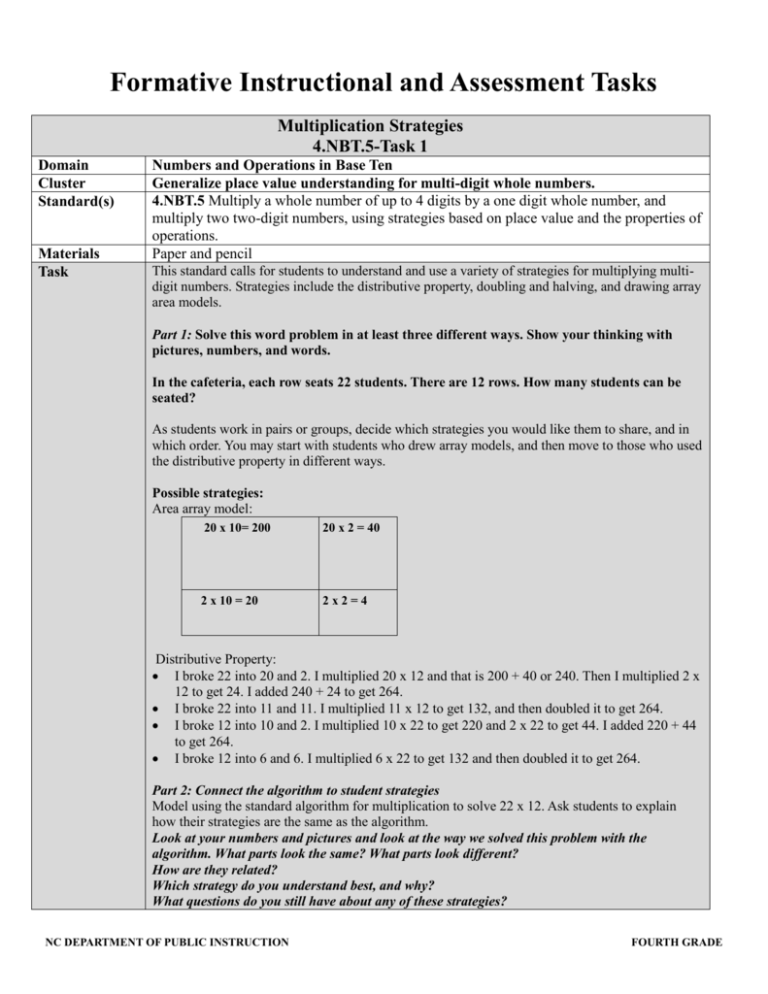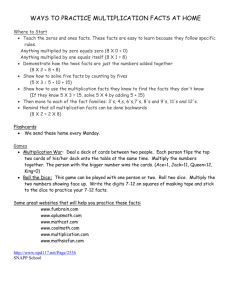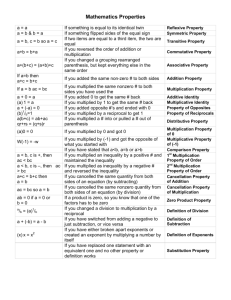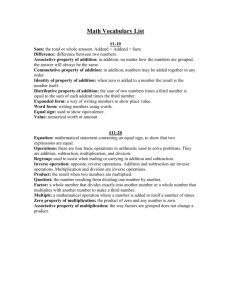4.nbt.5 Task 1 - 3
advertisement

Formative Instructional and Assessment Tasks Multiplication Strategies 4.NBT.5-Task 1 Domain Cluster Standard(s) Materials Task Numbers and Operations in Base Ten Generalize place value understanding for multi-digit whole numbers. 4.NBT.5 Multiply a whole number of up to 4 digits by a one digit whole number, and multiply two two-digit numbers, using strategies based on place value and the properties of operations. Paper and pencil This standard calls for students to understand and use a variety of strategies for multiplying multidigit numbers. Strategies include the distributive property, doubling and halving, and drawing array area models. Part 1: Solve this word problem in at least three different ways. Show your thinking with pictures, numbers, and words. In the cafeteria, each row seats 22 students. There are 12 rows. How many students can be seated? As students work in pairs or groups, decide which strategies you would like them to share, and in which order. You may start with students who drew array models, and then move to those who used the distributive property in different ways. Possible strategies: Area array model: 20 x 10= 200 20 x 2 = 40 2 x 10 = 20 2x2=4 Distributive Property: I broke 22 into 20 and 2. I multiplied 20 x 12 and that is 200 + 40 or 240. Then I multiplied 2 x 12 to get 24. I added 240 + 24 to get 264. I broke 22 into 11 and 11. I multiplied 11 x 12 to get 132, and then doubled it to get 264. I broke 12 into 10 and 2. I multiplied 10 x 22 to get 220 and 2 x 22 to get 44. I added 220 + 44 to get 264. I broke 12 into 6 and 6. I multiplied 6 x 22 to get 132 and then doubled it to get 264. Part 2: Connect the algorithm to student strategies Model using the standard algorithm for multiplication to solve 22 x 12. Ask students to explain how their strategies are the same as the algorithm. Look at your numbers and pictures and look at the way we solved this problem with the algorithm. What parts look the same? What parts look different? How are they related? Which strategy do you understand best, and why? What questions do you still have about any of these strategies? NC DEPARTMENT OF PUBLIC INSTRUCTION FOURTH GRADE Formative Instructional and Assessment Tasks Level I Limited Performance Students are unable to use a strategy to solve the multiplication problem. They may be able to use the algorithm to find an answer but cannot explain why it works. 1. 2. 3. 4. 5. 6. 7. 8. Rubric Level II Not Yet Proficient Students can solve the multidigit multiplication problem accurately in one way, but do not provide a clear explanation of why it works or how it is related to the standard algorithm for multiplication. Level III Proficient in Performance Students can solve the multidigit multiplication problem accurately in at least two ways, and can provide a clear explanation of why each strategy works and how it is related to the standard algorithm for multiplication. Standards for Mathematical Practice Makes sense and perseveres in solving problems. Reasons abstractly and quantitatively. Constructs viable arguments and critiques the reasoning of others. Models with mathematics. Uses appropriate tools strategically. Attends to precision. Looks for and makes use of structure. Looks for and expresses regularity in repeated reasoning. NC DEPARTMENT OF PUBLIC INSTRUCTION FOURTH GRADE Formative Instructional and Assessment Tasks Multiplication Strategies Part 1: Solve this word problem in at least three different ways. Show your thinking with pictures, numbers, and words. In the cafeteria, each row seats 22 students. There are 12 rows. How many students can be seated? Part 2: Look at your numbers and pictures and look at the way we solved this problem with the algorithm. What parts look the same? What parts look different? How are they related? Which strategy do you understand best, and why? What questions do you still have about any of these strategies? NC DEPARTMENT OF PUBLIC INSTRUCTION FOURTH GRADE








